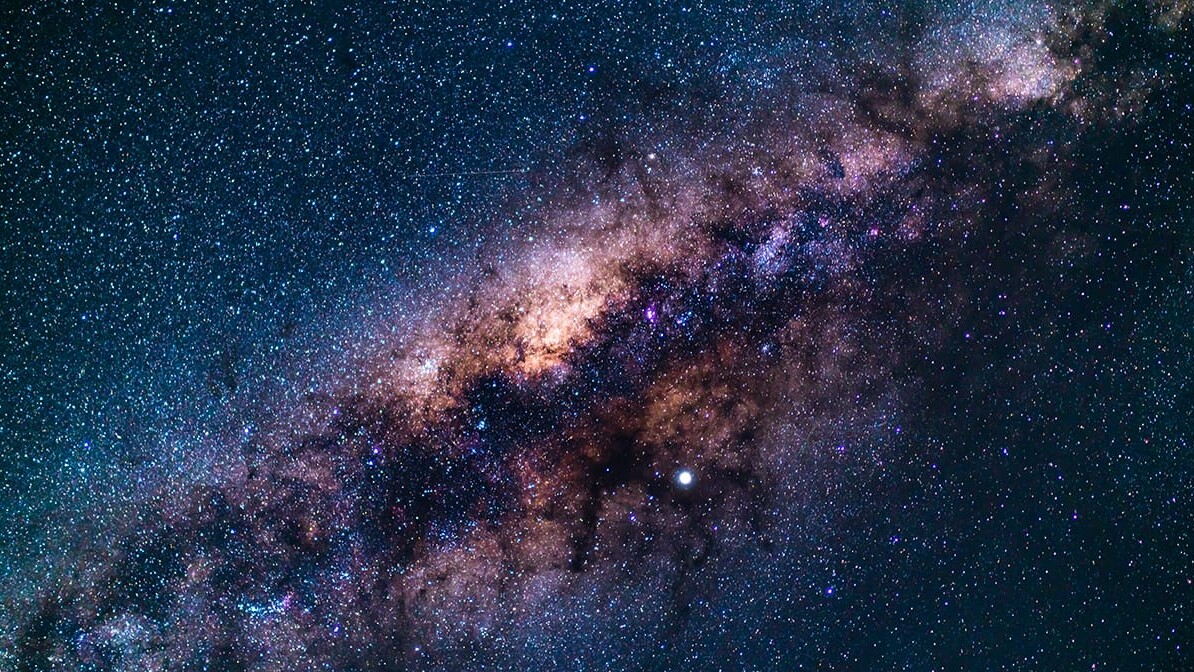- Home
- Spiritual Life
- The Vastness of Creation Points to an All-Powerful Creator

The Vastness of Creation Points to an All-Powerful Creator
I’m not the first one to make this observation. Three thousand years ago, David said, “The heavens declare the glory of God; the skies proclaim the work of his hands” (Ps. 19:1). David saw what you and I see. His eyes were focused on creation, but what he saw turned his mind to God.
The amazing thing is, David penned those words millennia before the James Webb Space Telescope was launched. The latest images sent back from space are dazzling, breathtaking. Peering deeper into space than man has ever been able to see before only confirms what we already knew: this universe is diverse and big. It is incomprehensibly vast. I see what we all see in the night sky with our naked eyes, but when I saw the Webb pictures for the first time, it left me speechless.
The only thing I could say was, “God, you really are there!”

David had no such access to technology. Still, he came to the same conclusion I did. He just looked up with his naked eyes and marveled. To him, creation was really big. We now know that it’s much, much larger than David could have known. But even then he was able to determine one thing to be true: the vastness of it all was more than he could fathom. And what he saw compelled him to utter the same name that I spoke—“God!”
Yes, the universe is large. But that word large is a relative term. A man standing six-foot-eight-inches tall and weighing 450 pounds would be considered large when you compare him to a skinnier or shorter man.
But from the deep recesses of space, he’s not much at all really. If we looked back at earth from out there, we couldn’t say that he would appear larger than the smaller man, because we wouldn’t have to travel too far above the earth’s surface before we wouldn’t be able to see him at all.
We aren’t talking about that kind of big. When speaking of the size of the universe, we’re way past that.
So, how big are we talking, Phil?
Once you crunch the numbers on the size of the cosmos, it almost makes the question laughable, because the answer is that no one really knows. What we do know is that the known universe is ninety-three billion light-years across. That’s a best-guess estimate. But that’s just what we know about. Scientists theorize there is more, much more. They just don’t know how much more.
So, we wonder, is the universe twice the size of what we know? Three times? And what if we even could see the outer perimeter of the cosmos? What’s after that? Nothing? But when you say that nothing is there, what in the world does that even mean? I can’t fathom nothingness because everything I have ever known is something.
As mind-boggling as the concept of nothingness is, what if this thing just goes on forever and ever? What if there is no end to it? Can we even imagine that?
We’re just getting started, and my head is already spinning! The only thing we can say is that the universe is larger than any human can grasp with his finite mind. So, to help us have a better idea of how big it all is (the part we know about), let me offer the redneck explanation for what a light-year is.
Light travels at 186,000 miles per second. By anyone’s calculations, that’s pretty fast. I know that [we] are accustomed to calculating speed in miles per hour, so let me break it down for all you NASCAR fans: light travels through space at 670.6 million mph. We say that things are “lightning fast,” but lightning is slow in comparison. It creeps along at only 276,000 mph. Lightning is the tortoise in the race with the hare. So when we say that the known universe is ninety-three billion light-years across, we are talking about a distance so vast that, even if humans could travel at the speed of light, no one human could ever complete the journey.
I also know what some of you dirt-track-racing boys are thinking: There’s gotta be a way to tweak that spaceship and make it go faster. Maybe a souped-up turbocharger would do the trick.
Sorry, Junior. It ain’t going to happen. Even if you and I could make it to the edge of the universe, and even if we could travel at the speed of light (which Einstein said is impossible), and if we traveled at that speed for an entire lifetime, we would have made almost no progress at all.[i] The distance is simply too great. More than we can imagine. Even if we could travel at 670.6 million mph, it would still take ninety-three billion years to make the journey.
All I can tell you is that you would need to pack your lunch if you set out to make a trip like that.
These are mind-blowing distances. Incomprehensible! But hold on, there’s more!
After considering the sheer size of the cosmos, I wondered exactly what is out there in space. How many stars? How many planets? What I found out is that there are so many celestial bodies in the universe we can’t even count them all.
Just our galaxy alone, the Milky Way, has approximately one hundred thousand million stars. But how many stars are in the universe? In total? All the best astronomers can do is make an educated guess.
The numbers are staggering. In all of the known universe there are from one million quintillion to two million quintillion stars in space.[ii] I am not sure how many that really is, but I think it’s one hundred to two hundred billion trillion.
This is way above my head, so let’s talk about galaxies. That should make it easier, right? Would you like to hazard a guess about how many there are? A hundred? A thousand? A million? Go big! Really big! Don’t be afraid of swinging for the fence here.
Opinions vary, but scientists estimate there are between two hundred billion to trillions of galaxies.[iii] And that’s just in the known universe.
We toss that word trillion around like it’s nothing. Politicians do it all the time. What’s a trillion dollars to a senator or a congressman? But it’s a really big number, so to give you an idea of how big, let me give you an analogy.
If you were to borrow a million dollars and pay it back at the rate of one dollar per second, it would take you eleven days to repay your debt. Borrow a billion dollars and pay it back at the same rate, and you would be debt-free in around thirty years.
But, and this is where we begin to realize just how big a trillion is, if you borrowed a trillion dollars and paid it back at one dollar per second, it would take you thirty thousand years to get out of debt.
We aren’t talking about one trillion galaxies, but trillions, as many as two hundred trillion.
Meanwhile, all of these galaxies, stars, and solar systems are operating methodically and rationally. They move in a sort of cosmic dance that is repeated year after year, millennium after millennium, spinning, rotating, hurtling through space in an orderly fashion that almost looks like someone organized things that way.
I will remind you again that this is exactly what David said in Psalm 19: “The heavens declare the glory of God; the skies proclaim the work of his hands” (v. 1). Once again, David came to the same conclusion that you and I have come to: God! Not a doubt in his mind or mine. Even without the technology that permits us to gaze deeper into the bowels of the universe than David ever dreamed possible, he was still able to see the heavens and skies for what they were—evidence that God is real. He knew that it is impossible for everything that exists to begin to exist if there weren’t someone far superior to mankind behind it all. Someone bigger and more powerful than the human mind can comprehend.
…
[i] Vicky Stein, “What Is the Speed of Light?” Space, May 17, 2023, https://www.space.com/15830-light-speed.html.
[ii] Amanda Barnett, “Beyond Our Solar System,” Solar System Exploration, April 20, 2023, https://science.nasa.gov/solar-system/.
[iii] Ailsa Harvey and Elizabeth Howell, “How many galaxies are there?” Space, February 1, 2022, https://www.space.com/25303-how-many-galaxies-are-in-the-universe.html; see also “How Many Galaxies are there in the Universe,” The Nine Planets, September 29, 2020, https://nineplanets.org/questions/how-many-galaxies-are-there-in-the-universe/.
Adapted from I Could Be Wrong But I Doubt It. Copyright © 2023 by Phil Robertson. Published by Thomas Nelson. Available wherever books are sold.
Order your copy of I Could Be Wrong, But I Doubt It: Why Jesus Is Your Greatest Hope on Earth and in Eternity by Phil Robertson
Trending Now
Sign up today for your Inspiration Today Daily Newsletter
Supercharge your faith and ignite your spirit. Find hope in God’s word. Receive your Inspiration Today newsletter now!
Phil Robertson
Phil Robertson is a professional hunter who invented his own duck call and founded Duck Commander. He also starred in the hit A&E series "Duck Dynasty," is the host of the hugely popular podcast "Unashamed with the Robertson Family" and discusses the Robertson Family story as part of "The Blind Movie Podcast." Robertson and his wife, Kay, live in West Monroe, Louisiana. Learn more at duckcommander.com
Related Articles
December 12, 2025
Discipleship Without Borders: How Free Online Resources Change Lives
Every day, people around the world come to Jesus through our ministry—and many of them long for…
December 11, 2025
A Heart for Africa: Partner in Global Christian Missions & Gospel Outreach
Dr. David Livingstone gave his life to reach Africa with the Gospel. Today, your generosity…
December 9, 2025
Partners for the Great Commission: Activating the Gifts God Placed in You
The Great Commission is one of the most extraordinary invitations God gives His people—an…
December 8, 2025
Good Without God? Why Being Nice Won’t Get You Into Heaven
Can someone be good without God—and is goodness enough to get us into Heaven? Our culture loves the…
Next Steps To Strengthen Your Walk
Inspiration Today Newsletter
Supercharge your faith and ignite your spirit. Find hope in God’s word. Receive your Inspiration Today newsletter now!
Christian Articles
Find articles to strengthen your walk and grow your faith. We have a wide range of topics and authors for you.
Submit A Prayer Request
We are here for you. Simply click on the button below to reach us by form, email or phone. Together we will lift our hearts and voices with you in prayer.





